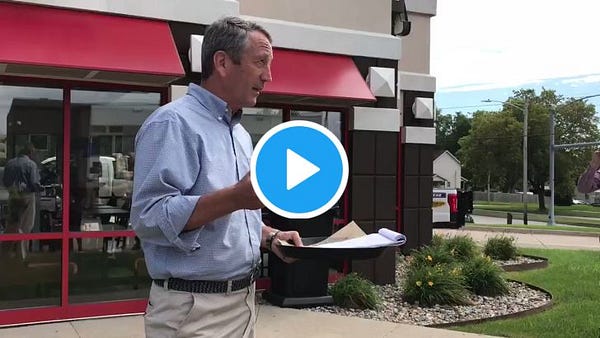Watching Mark Sanford run for president was like watching a small dog trot beside a busy highway, yipping at nothing in particular and chewing at wounds you’d rather not know the story behind.
In case you blinked and missed it, the former South Carolina governor and U.S. Congressman was running for the Republican presidential nomination in 2020.
Sanford spent much of the last two months wandering through Iowa and New Hampshire in search of a voting base or even an audience. Finding neither, he called it quits yesterday, telling a cluster of reporters outside the New Hampshire Statehouse, “You gotta be a realist.”
Realism was never Sanford’s strong suit. An anti-tax crusader and errand boy for the billionaire class, he enjoyed a brief ascendancy during the Tea Party era, only to fade from national prominence after he lied about a sex scandal while in office.
His politics fell out of fashion, anyway. When an insurgent candidate beat him in a Congressional primary in 2018, she announced, accurately, “We are the party of President Donald J. Trump.” The party traded one brand of cruelty for another, and Sanford was tossed aside.
In place of realism, Sanford’s 2020 presidential bid had a surreal glow about it. He entered the national stage in September while standing outside an Arby’s restaurant in Des Moines, gesturing at cameras with a limp sandwich as he quoted an ancient Wendy’s commercial: “Where’s the beef?”


It would be a stretch to say I was pulling for Sanford to win the 2020 Republican presidential nomination, but he did command a certain bumbling pathos.
I almost pitied him when the South Carolina Republican Party declined to hold a primary, denying him the opportunity to compete in his home state.
I winced when he held a campaign event in Philadelphia and literally one person showed up to watch.
And who could forget the sight of Sanford debating a cardboard cutout of Trump, a man who couldn’t be bothered to lob a coherent insult at him on Twitter?
I’ve long ago grown incurious about the inner lives of politicians, but the abject failure of Sanford’s run is worth analyzing. His particular aesthetic may have fallen out of style, but his policies are still harming people back here in South Carolina.
***
Pigs shat on the floor of the South Carolina Statehouse. Gov. Sanford had brought the pigs into the House chambers to punctuate a speech about supposed “pork projects” in the 2004 budget the legislature had sent to his desk.
Republicans had just clinched power in the state House, Senate, lieutenant governor’s office, and governor’s mansion for the first time since Reconstruction. But Sanford constantly sparred with his own party, vetoing broad sections of every budget the legislature passed.
Political reporters still chuckle when you bring up the pig incident. And while the folksy charm of Sanford’s stunt was undeniable, it provided cover for the actual damage he was doing.


Sanford’s anti-tax, anti-spending stance was extreme even by South Carolina standards, and it proved to be incoherent. He liked to preach about the need to balance the budget like a family checkbook, yet one of his lasting legacies is a tax policy that blows a hole in public school budgets year after year.
He signed Act 388, a 2006 law that eliminated the homeowner property tax that paid for school operations. A one-penny increase in the state sales tax was supposed to make up for the lost revenue, but it didn’t, particularly during the Great Recession.
Sanford swapped out a progressive, stable tax revenue stream for a regressive, unstable tax revenue stream. By setting taxes higher for non-homeowner occupied houses, he also shifted a larger share of the state budget onto the backs of renters. This is ECON 101 stuff.
The net effect is that South Carolina has some of the country’s lowest property tax rates, and some of the lowest-paid teachers.
Sanford endorsed Nikki Haley to replace him as governor, and in important ways she carried on his legacy. Her decision to reject Medicaid expansion for South Carolinians resulted in unnecessary deaths and the closure of rural hospitals serving some of America’s poorest counties.
My kids attend the schools that Sanford attacked. My friends teach in the crumbling school buildings. I drive to work on our crumbling roads and bridges. But that’s not why you know Mark Sanford’s name.
To the extent people know about Sanford outside of South Carolina, it’s in the context of a punch line. In the summer of 2009, during his second term as governor, Sanford disappeared for a few days, telling his staff he was going to hike the Appalachian Trail. He ducked calls from his chief of staff and didn’t call his family on Father’s Day.
You know where this is going. He was actually in Argentina, visiting a woman he was having an affair with. A reporter caught him on the way home at the Atlanta airport, and he made his weeping confession on live TV.
“Hiking the Appalachian Trail” became the euphemism of the year, and Sanford — once floated as a presidential prospect — became a lame duck governor and a national laughingstock. Call me a killjoy, but I never found the episode very funny.
***
Out on the presidential campaign trail this fall, Sanford wasn’t challenging Trump’s openly racist border policies, his self-dealing and nepotism, or his role in the entrenchment of oligarchic power at the expense of working people. Sanford was running to raise awareness of the national debt, an issue that his party and base have proven not to care about at all since gaining power.
Of course he failed. In a way I’m grateful to him for running, if only to put a final nail in the myth of the Republican Party’s “fiscal conservatism.” Sanford’s jeremiads about out-of-control spending seem so quaint now.
This is probably not the last we will hear from Sanford. His style may come back in vogue in time for him to run for office again. He may even seek rehabilitation in the public eye as a member of the anti-Trump “resistance.” Stranger things have happened.
When he returns, feel free to laugh — but know that the joke was on us.
***
The image at the top of the page is by the 17th-century Flemish painter Frans Snyders.





